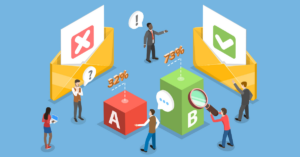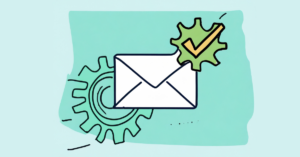You are not alone if you feel like it’s been even more challenging to hit the inbox consistently. Personalization and relevancy aren’t a guarantee that you will land in the right spot, but it does play a role.
Find out how experts in email answered our question:
Relevancy in email has been part of the conversation for over 20 years—in 2022, as personalization evolves and bubbles to the top of the conversation, how does the definition of relevancy change?
The Experts
Christopher Donald | InboxArmy
Betsy Grondy | Blackhawk Network
Scott Hardigree | Email Industries
Kath Pay | Holistic Email Marketing
True Personalization aka Dynamic Content

Christopher Donald | Managing Partner at InboxArmy
Relevancy, as it pertains to personalization, covers a wide range of content but the definition hasn’t really changed much, the simplest view is adding a person’s name to a salutation ( ex. Dear Chris).
But true personalization brings dynamic content into view for the subscriber, a true one-to-one message based on their preferences and/or digital body language. Content-based on what they clicked, viewed, bought, shared, recommendations, etc. Personalization of sending day and time of day and so on. It’s extremely effective when executed with a plan and the data to back it up, and the revenue/conversions it generates shows it works.
[Hops on soapbox] But the problem with this is far too many programs (small, mid-size, and large) do not have the budget, resources, man-hours, and/or tools to use that data properly to achieve these goals of hyper-personalization so they take baby steps as best they can. You want real relevancy, real one-to-one personalized communications through the email channel? Then give it the budget it deserves, it will pay you back and your email marketing person or team will thrive and be happier and more effective. [Hops off soapbox.]
Personalization is Expected

Betsy Grondy | Sr. Email Marketing Manager at Blackhawk Network
We’ve said for years that email marketing success is defined as “the right message to the right person at the right time” and personalization is definitely a component of this.
When I first started in email, personalization was using the contact’s name in the email somewhere. Nowadays, subscribers expect us (brands?) to use more of the data we have on them to inform the campaigns we send. They expect more personalization and that was especially true through the pandemic.
Personalization can be using past purchase behavior or browsing data to populate email. But it can also be creating segments based on their interactions.
Email subscribers today know that we have data on them (beyond the Cookie Consent that is on nearly every website). They not only expect us to use that data, but to use it in a way that is meaningful to their experience.
Think about it like this: let’s all imagine (in a pre-pandemic world) you are at a party and talking with someone about your favorite color orange. When they begin to speak they go on and on and on about blue triangles and how magnificent they are. After listening with a puzzled expression, you casually excuse yourself from the conversation and move on or unsubscribe, if you will.
This is exactly what our subscribers do as well—when email marketers don’t use the cues and information we’ve been given, they stop paying attention to us.
Relevancy is the Key to Deliverability Too
Scott Hardigree | Founder of Email Industries
Getting your emails to the inbox has never been guaranteed, but if you’ve been finding it more challenging to hit the inbox consistently, you’re not alone.
It’s important to remember that there’s not a person at Goggle, Microsoft, or Barracuda who decides where to place your emails.
Instead, they are reliant on sophisticated machine learning algorithms that are adept at interpreting signals that may indicate whether people want to read your emails or not.
Subscriber engagement, for example, when people not only open and click your emails but where they move them and how long they read them, has risen to the top of the list of positive signals that these mailbox providers and most modern spam filters look for.
And it comes as no surprise that the best way to get subscribers to engage with your emails is to make them more relevant, and the best way to increase relevance is to personalize your emails to reflect your subscriber’s persona or journey.
Personalization and Relevancy Are Subjective

Lisa S. Jones | Chief EyeMail Officer at EyeMail Inc.
The art of Email Personalization has many dimensions. Is adding a postscript (P.S.) at the end of an email considered personalization, or possibly adding a recipient’s first name at the beginning or in the subject line of an email message considered personalization? The answer depends and is based on your individual perspective. When we think about the email inbox, it’s a 1-to-1 personal experience when we are viewing, replying, and/or sending messages. Relevancy is based on preferences, interpretation and experiences and is not an exact science.
As we continue to navigate the landscape of email personalization and relevancy, the definition will continue to evolve and impact more communities. At a core level, relevancy helps us to be seen and heard and to feel understood. Relevancy going forward will also mean actively practicing more empathic listening and to employ these learnings to the tone of email messages, that resonates with the recipient. This requires placing yourself in the other person’s shoes by connecting with their point of view, thoughts and feelings, and translating this into a thoughtfully crafted email message.
Another perspective of email personalization and relevancy is to ensure inclusiveness and accessibility for people with disabilities. This requires taking a deep-dive review to ensure your email messages are mindful of the needs for others, who may use screen readers and other assistive technologies to view email. Some of the actions for personalization will include describing visual objects with alternative text, making content easy to navigate, running accessibility checkers and supporting guidelines.
My prediction forthcoming: the importance and mass adoption of auto-play video in email experiences will become a standard measure of engagement for email personalization and relevancy for email marketing messages. We, as a global community, understand the challenges of the inbox clutter and will continue to seek ways to stand out as a competitive differentiator. This realization and tailored experience will further advance, define, and reshape the lens of email personalization and relevancy.
Finding the Right Approach

Dmitry Kudrenko | Founder of Stripo
The meaning of Relevancy has dramatically changed over the past few years due to fast-growing technologies, the maturity of marketers, and the variety of channels where the customer interacts with a brand.
Technically, Relevancy is about how to use customer data so that customers feel cared about.
The 3R rule grew into the 8R rule, which now means: Deliver the Right Message to the Right Person at the Right Time, to the Right Folder, using the Right Channel in the Right Context, in the Right Language and it should look Right on the customer’s device.
Previously, customer data along with the order history were Right enough, however, today it is important to track user activity on a website, offline, in a mobile application along with his or her activity in email/SMS/push/chats, etc. to see the whole picture. Moreover, user behavior patterns now also change quite often and you need to respond to these changes flexibly.
The GDPR ruling, third-party cookies usage restriction and Apple MPP make it harder and harder to collect customer data. It is impossible to find the Right components without the AI/ML algorithms.
However, despite all these difficulties and changes, one thing remains unchanged—Relevancy is not about technology, it is about people. And it is the marketer’s duty to find the right approaches so that the client stays with the brand for as long as possible.
Achieving Relevance and Value

Kath Pay | CEO, Founder & Author at Holistic Email Marketing
There are still so many definitions of personalization, that it depends upon which definition is being used. If we’re talking about a personalization strategy that is achieved by segmentation, then the existing definition of relevancy still remains. However, if we’re using the definition of 1:1 Personalization that is achieved by using AI/ML, then relevancy becomes less relevant, and I believe we begin to talk about achieving value instead of achieving relevance.
I say this because offers, items, content etc. can be relevant, but not valuable to the subscriber. If the timing is wrong or the price is wrong etc., the email whilst to all intents and purposes, could be relevant, but not valuable, and hence, not actioned. When using AI/ML, we’re more likely to be able to tailor the message using multiple data sources (including recency or timing) to not only be relevant, but also valuable.
Personalization at Scale

Ryan Phelan | Managing Director at RPE Origin
What comes to mind first is that personalization is the new relevancy.
We have been talking about achieving relevance for 20 years. Personalization is an extension of that conversation—a tangible way to persuade subscribers to open, read, comprehend, and act on our emails.
The answer is to personalize them. Sure, you can put their first name or location in the subject line or message copy, but that’s just phoning it in. To achieve relevance at scale, you have to work harder, and the same is true for personalization.
It takes data, analysis, personas, models, and algorithms to get it right and make it meaningful.
It’s a big step from using “fname/lname” to creating an algorithm that uses propensity to create a unique email for each of your thousands of recipients.
Incremental innovation will get you there. You start small—adding that first name if you don’t do it already—and then testing it, tweaking it, getting it right and moving on to the next step.
You could change an image based on a data attribute. Introduce dynamic content based on data attributes. Switch the order of promotions around based on data attributes.
The problem with relevance is not that you can’t achieve it, only that it’s achievable only over a longer time because you have to learn how to do it and make it part of your email muscle memory.
If you want to achieve personalization at scale, you have to get on the scale first.
Let’s Build a One-Topic Strategy

Jordie van Rijn | Email Marketing Consultant at emailmonday and Founder of Email Vendor Selection
Here is a little exercise – it’s based on something I noticed; Publishers regularly do separate one-topic (and often temporary) email newsletters. This is where readers can subscribe to a newsletter on just one topic, or, for instance, only the articles from a single writer they love. What is more relevant than a person saying, “Yes, I want to hear about this exact thing and only that“?
It is a fascinating prism to look at your (personalization) strategy with fresh eyes. Every brand is a publisher today, so ask yourself: How would I handle my One-Topic newsletter?
What are the hot and trending topics in your industry? What does your audience care about? What are their concerns? What makes them happy, angry, or interested—today, right now?
Some advanced list building tools can show contextual prompts, in-text, or dynamic pop-ups alongside your topical blogs. eg: “Want to keep up to date on topic X? Subscribe here”. Or even small tools to find out the interest. With a quiz, calculator, etc.
Consider a smart way to serialize your content, even if they are already published blogs or evergreen webinars on demand. Mix it up with updates on new pieces; just have the recurring theme in there.
Once you have established their preferences, segmentation and reader engagement will come by itself. In the ideal situation, your reader feels their emails are built around one topic: their interests.
Need help bringing personalization and relevancy to your email strategy? Contact us at expert@emfluence.com!


